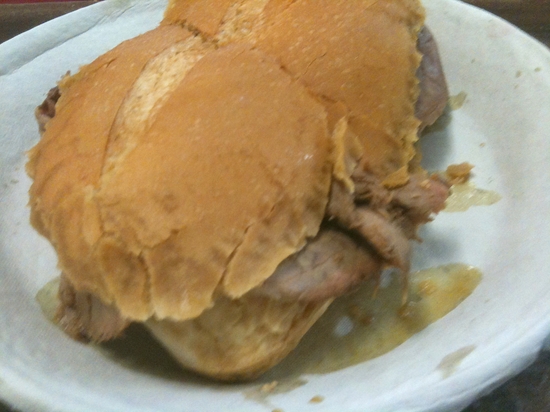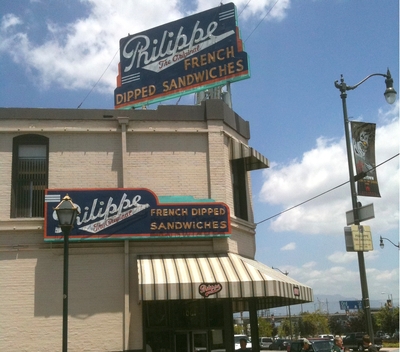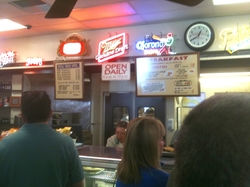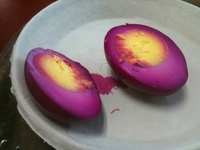Out There: July 2010 Archives

Recently I took a short break from intense and gratifying work with 25 theater and arts critics in Los Angeles, at the NEA Institute in Theater and Musical Theater, and avoided lunching yet again at the gastronomically hypnotic Lazy Ox Canteen. Instead, I strolled on a gorgeous bright day from our Little Tokyo hotel past Olvera Street, bathed in hubbub and jacaranda light, to Philippe the Original, the not-original, post-WWII site of one of the oldest restaurants in Los Angeles. I had mentioned Philippe -- everyone calls it Philippe's -- to my hungry colleagues on an earlier tour through nearby Union Station, but we hadn't the time for a visit. My goal now is to add roast beef regret to an illuminating afternoon.
There's no easy or original explanation for my dogged fascination with food eaten in the past. For years I have collected defunct menus, and each of them, especially the most modest, conjures an actual lunch or dinner for me, right there on the table, served with a Kodak smile. Of course, that smile is a long-dead thing, and the piping hot meatloaf or buttery sole almondine or juicy fried chicken with beaten biscuits set with such ease before us have long ago found their various ways to oblivion.
Yet we are hungry every day, and food is always new. So here there they are again as always, my grease-hot, half-dollar treats, pre-Hiroshima sustenance, tasting of Hollywood's bottle-blond innocence and unworried by the chemical, political cynicism that properly clouds every thoughtful 21st-century meal.
How perverse can it be to love the past, when love of any kind is so dear, so hard to come by? Perhaps I would have hated being stuck in the 1920s or '30s, always wishing for some freedom that the spaceship future would bring. But even the future of the past seems to glow, compared to the future of now.

So I cross the dangerous street and walk into Philippe's, all by myself. Being alone is an advantage in a lot of eating situations, especially when you wish to be a kind of spy, stationed in a foreign place.
Harsh sun outside, no hint of that within. Stools under long, high, worn wooden tables made for communal eating fill the main room, lined perpendicular to the counter at which you stand on one of a half-dozen lines to order your food. Walk among the diners and through the threshold up to that counter, and turn the clock back 50, 60 years.
Who are the folks here with me? A donut-box assortment of language, color, age, dressed in such a noncommittal fashion that you can't really tell time or place. Money simply does not define this ordinary, murmuring clientele. Is that sawdust on the floor? (Who nearby still cuts wood?). No one comes here to spend. Everyone is here to eat.
Not long ago, a close friend dismissed as tasteless and worthless the "overdone" sliced beef that makes a Philippe's French Dipped sandwich. Well, she's wrong, completely and utterly. It's not underdone or overdone. It's exactly in the middle, unconcerned.
"Hi. I'd like a beef dip."
"Single or double?"
Double means more dip -- in a light and natural pan-juice. They dip in advance and don't provide a monkey dish filled with salty brown broth for you to play with, as some other L.A. French Dip places -- uh, Cole's -- do. Phillippe claims to have invented this fetching wetting technique in 1918, but Cole's Pacific Electric Buffet, in its original downtown site, also fights for that distinction. You can read about their old, mild rivalry here. No contest in the result.

The white-haired lady serving me indicates by magic mental waves that only fools get double beef juice. When you order, you say "beef" because there's also pork, ham, lamb and turkey to be had. I guess they're good, but who would want lamb or turkey juice dampening that nice roll? She has gloves on, and stands in charge of a metal tray of just-sliced meat-portions from the back. She dips each piece of bread herself.
It's not soggy. Double is soggy.
Because the beet juice-pickled eggs in giant glass jars sing their ruby song, I ask for one, and also get a cole slaw side. The touted mustard at the table (in squeeze-bottles, no more glass pots) is almost too hot and dominating, so I merely test it to be sure it's the same.

What kind of lunch is this? That's not a simple question. First, no matter where the beef is from, it's real cooking, the result of a series of specific marketing and kitchen decisions made over time, not a preprocessed idea turned to profit. You could make it anywhere, I suppose, but the beef sandwich is dipped in this very location on North Alameda as much as it's dipped in the jus. The meal's affordable -- beef is $5.75 -- but not so cheap as to lose its value, its identity.
Because of the food's "realness," it knits together the many customers with a sort of edible honesty. There's a shared, civic sense that this restaurant and its food should be here, and surprisingly little nostalgia for old times or mourning that this may be the last of its kind.
I am biting into warm, moist beef on a roll.
I am so peaceful, so pleased, so removed from my age, that I can still taste it.
-thumb-350x247-16015.jpg)
